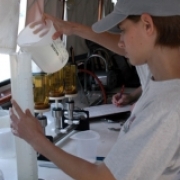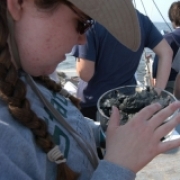Eight students will be presenting the summer work at the Ocean Sciences Meeting in March 2022!
Our Students and Their Research

You may search for students by class year and keywords found in the student's name, university, project title or abstract. Our first class was in 1989.

Mentors: William Boicourt, Ph.D.
Location: Horn Point Laboratory
Project: Variability and Effects of Wind Mixing on Dissolved Oxygen Depletion and Estuarine Circulation in the Chesapeake Bay


Mentors: Andy Lazur, Ph.D.
Location: Horn Point Laboratory
Project: Nutrient Uptake Potential of Four Freshwater Ornamental Plants

Mentors: Ronald Siefert, Ph.D.
Location: Chesapeake Biological Laboratory
Project: Ammonia Flux Measurements at the Air-Water Interface on the Chesapeake Bay

Mentors: Michael Roman, Ph.D.
Location: Horn Point Laboratory
Project: Effect of a Restored Oyster Reef (Crassostrea virginica) on Water Quality in a Subestuary of the Chesapeake Bay

Mentors: Byron Crump, Ph.D.
Location: Horn Point Laboratory
Project: Estuarine Bacterioplankton Metabolism and Diversity Across a Seasonal Oxygen Gradient

Mentors: Michael Kemp, Ph.D.
Location: Horn Point Laboratory
Project: Nutrient Cycling and Biogeochemistry of Sediments Inhabited by Two Contrasting Submersed Plant Species

Mentors: Michael Roman, Ph.D.
Location: Horn Point Laboratory
Project: Grazing Habits of Eurytemora affinis and Acartia tonsa in Turbid and Non-Turbid Environments

Mentors: Carys Mitchelmore, Ph.D.
Location: Chesapeake Biological Laboratory
Project: Evaluating DNA Damage in the Blue Crab (Callinectes sapidus) Collected from the Chesapeake Bay and its Tributaires Using the Comet Assay

Mentors: Roberta Marinelli, Ph.D.
Location: Chesapeake Biological Laboratory
Project: The Impact of Ammonium on the Hrowth of Arenicola cristata Within Light and Dark Treatments

Mentors: Evamaria Koch, Ph.D.
Location: Horn Point Laboratory
Project: Linking Oysters and Seagrasses: Using Breakwaters as an Analogue to Oyster Reefs

Mentors: Michael Kemp, Ph.D.
Location: Horn Point Laboratory
Project: The Biogeochemistry of Plant-Sediment Interactions in Contrasting Ruppia maritima Beds

Mentors: Roger Newell, Ph.D.
Location: Horn Point Laboratory
Project: Use of Fluorescent Particles to Determine the Zone of Oyster Biodeposition Under Field Conditions

Mentors: David Secor Ph.D.
Location: Chesapeake Biological Laboratory
Project: Epifaunal Feeding Ecology of the Lined Seahorse, Hippocampus erectus, in Selected Locations in the Chesapeake Bay

Mentors: Lawrence W. Harding, Jr.
Location: Horn Point Laboratory
Project: Flow Cytometric Indicators of Phytoplankton in the Chesapeake Bay.

Mentors: Jeffrey Cornwell, Ph.D.
Location: Horn Point Laboratory
Project: The Influence of Microphytobenthos on Resuspension in Shallow Estuaries: A Comparison Between the Florida and Chesapeake Bays

Mentors: Gerdhardt Riedel, Ph.D.
Project: Trace Mercury Uptake by Spartina alterniflora in Mesocosm Simulating Capping, Marsh Restoration, and Phytoremediation.

Mentors: Marcelino Suzuki, Ph.D.
Location: Chesapeake Biological Laboratory
Project: Development of a Novel Approach to Determine the Effects of Protist Grazing on Marine Bacterial Diversity

Mentors: Joel Baker, Ph.D.
Location: Chesapeake Biological Laboratory
Project: Binding Capabilities of Polychlorinated Biphenyls (PCBs) to Dissolved Organic Carbon and Chesapeake Bay Sediment

Mentors: Denise Breitburg Ph.D.
Project: The Distribution of Zooplankton and Phytoplankton as a Food Source for Gelatinous Zooplankton In Sites Within Small Inlets and the Mainstem of the Patuxent River


